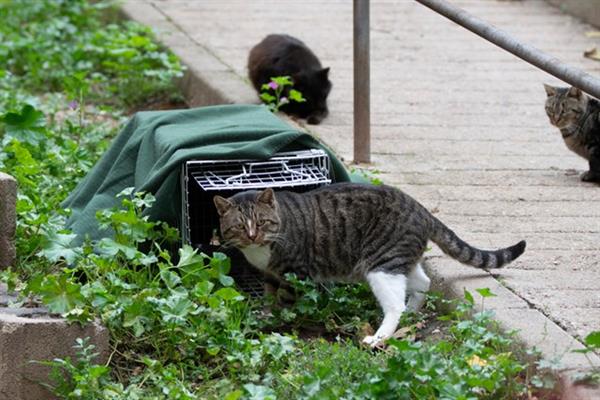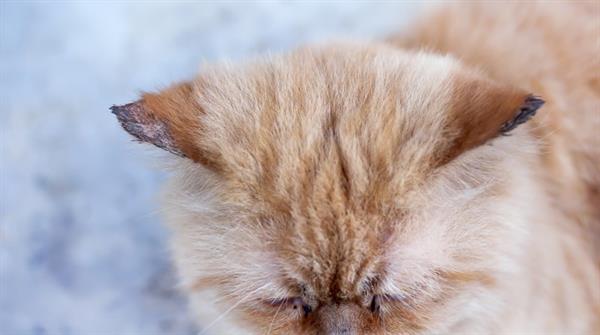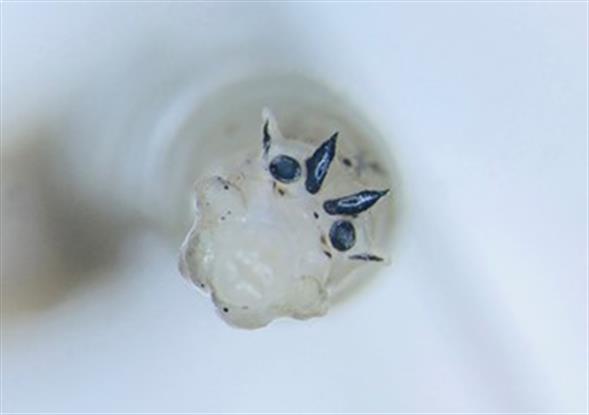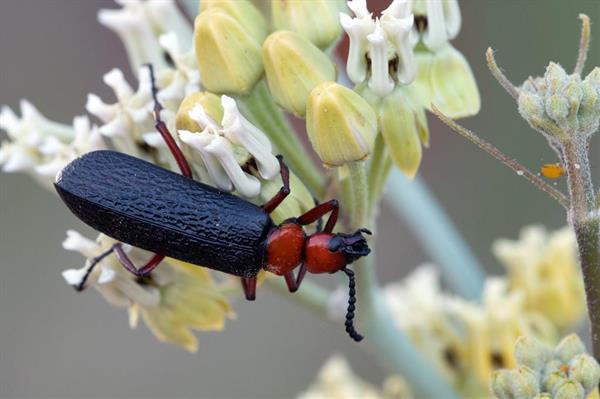
Our thanks to Tony Scarfo (Phoenix Union High School District) & Tim Barrett (Grand Canyon University) for requesting this topic
Dawn H. Gouge1 Tim Stock2 Shaku Nair1 & Shujuan (Lucy) Li1
1Department of Entomology, University of Arizona
2Department of Horticulture, Oregon State University
"As every cat owner knows, nobody owns a cat." – Ellen Perry Berkeley
Feline fanatics over the ages have generally agreed that the anthropocentric notion that cats are a domesticated species is indeed an oxymoron. However, even free-roaming cats are synanthropic, meaning that they live in close association with humans, and benefit from us. Evolutionary geneticist Carlos Driscoll is quoted as saying "We think what happened is that the cats sort of domesticated themselves". Suffice to say that our cat companion Felis catus (Figure 1), a descendant of the European wildcat Felis sylvestris, has lived alongside us for thousands of years and they will likely remain with us for thousands more.

Figure 1: Companion cats have lived with and alongside us for thousands of years.
During the spring cats often become more evident in the urban landscape, and questions often arise regarding the risks to human health they pose. Here we present some science-based considerations and note that each specific situation is as unique as the individual animals involved.
Feral, free-roaming, stray, community cats, wild cats, campus cats, wildcats – what’s the difference?
Feral cats are unsocialized outdoor cats. Although they are descendants of domestic house cats, they behave differently due to a lack human contact as kittens, most having fended for themselves from a young age. Feral cats are often far more fearful of humans compared with free-roaming cats or stray cats, which have been accustomed to humans as positive care providers. Free-roaming cats (also sometimes called free-range) can be indoor-outdoor cats or animals who are fed and cared for primarily as outdoor pets. Stray cats are pets who once lived and socialized with people but have lost their home and caregivers for some reason and no longer have regular human contact. The offspring of stray cats can be considered feral if they are born in the wild. Terms like “wild cats”, “community cats” or “campus cats” are umbrella terms that refer to any Felis catus who is unowned and lives outdoors, campus cats being associated with school and college campuses. These cats have a wide range of behaviors and degrees of socialization, but generally do not want to live indoors and may not be adoptable. Young kittens being a reliable exception.
Wildcats are a species complex that includes the European wildcat (Felis silvestris) and the African wildcat (Felis lybica). Here we have to mention the growing population of University of Arizona Wildcats most commonly encountered in the Tucson area.
Community and free-roaming cats impact other species – including us
Cats can have enormous impacts on the ecology of urban and rural environments. Even when cat food is provided, a cat is an instinctive hunter (Figure 2) and will impact populations of other creatures in its range. These may be native, or introduced species. Cats will predate on birds, small mammals, reptiles, and amphibians and may significantly reduce these populations. They compete with other native predators, and on occasions serve as transfer species picking up disease-causing pathogens and parasites from wild animals and transferring them to domestic animals or humans.

Figure 2: Cats are predatory and even if they are well fed, will hunt.
Quarantine and social restrictions during the COVID-19 pandemic led to a significant proportion of society experiencing social isolation and loneliness. Many people found companion animals helped to reduce stress warding off potentially serious mental and physical health consequences. A study published by Jezierski et al. (2021) found that two-thirds of survey respondents indicated a reduction of their own psychological tensions due to having a pet cat during the pandemic (Figure 3).

Figure 3. Researchers found that the welfare of pet cats was not adversely affected by the pandemic, and the human-cat interaction had positive effects on the owners during the lockdown (Jezierski et al. 2021).
Campus cats are not always a CATastrophe – but populations need resources and active care
The City of Tempe is well known as a home for what is estimated to be approximately 10,000 feral cats. Arizona State University students see them while walking on campus day and night. The campus cats are cared for by a nonprofit organization called “Mildcats at ASU”. The animal advocacy group is “dedicated to ensuring the long-term welfare of the homeless cat population on the campus of ASU”. The organization members work hard to trap the friendlier cats (Figure 4) with the aim of neutering and placing them in forever homes. They also trap the untamable kitties, who are sterilized and ear tipped, given vaccinations, and returned to campus. The organization maintains feeding and watering stations for the campus cats.

Figure 4. Some organizations operate TNR (Trap-Neuter-Return) programs to maintain stable, healthy populations of cats in an area.
What are the disease risks that can affect humans?
Most feline infectious diseases primarily affect cats, but some can be transmitted from cats to people. Diseases that can be transmitted from animals to people are called zoonotic diseases. The chance of an average healthy person contracting a zoonotic disease from a cat is very low, but infants and people with compromised immune systems are more susceptible. This includes those with acquired immunodeficiency syndrome (often referred to as AIDS), the elderly, people undergoing cancer chemotherapy, or anyone receiving drugs that suppress the immune system.
Cats that do not receive routine veterinary care can carry a variety of parasites and pathogens that are normally treated or prevented. Intestinal parasites have been found to be abundant in certain instances, with kittens typically carrying higher rates of parasites compared to adult cats (Labarthe et al., 2004). If you find kittens, please take them for veterinary care at your earliest opportunity.
So here is what you should know about the zoonotic diseases that may be carried by cats
Bacterial Infections
Cat scratch disease is caused by the bacterium Bartonella henselae which is carried in the saliva of infected cats and cat fleas. People may be infected if scratched by cat claws contaminated with infected flea feces, bitten or have open wounds licked by cats carrying the bacteria (Figure 5). Cats rarely show any sign of carrying this bacterium. But cats infested with fleas should be treated with a flea control product, as multiple issues are linked to cat fleas.

Figure 5: Thoroughly wash cat scratches and bites for several minutes with soap and water. Consult a medical care provider if symptoms develop.
Pasteurella multocida is another bacterium found naturally occurring in the mouths of most cats, and it has been found associated with cat bites in humans that become serious enough to seek medical attention. Bite wounds can be painful, swell, and redden at the wound site within 24 to 48 hours. Pasteurella-infected cat bite wounds can be treated with antibiotics.
Salmonellosis is caused by Salmonella bacteria, and can lead to diarrhea, fever, and stomach pain beginning one to three days after infection. People usually contract salmonellosis by eating contaminated food, such as undercooked chicken or eggs, but it is possible to contract the disease from infected cats, which can carry the bacteria in their digestive system. Salmonellosis usually resolves untreated, but some individuals may require medical attention if symptoms are severe diarrhea, or the bacterium spreads outside of the digestive tract. Salmonella is more commonly found in cats that feed on raw meat or wild birds and animals. Wearing gloves when cleaning litterboxes and washing hands thoroughly is imperative (Figure 6).

Figure 6. The importance of handwashing cannot be overstated. Wear gloves when cleaning out litterboxes, and wash hands thoroughly after removing gloves.
Fleas are the most common ectoparasite of cats, and flea bites can cause itching and inflammation in sensitive humans and cats. Fleas may also serve as vectors of tapeworms and on rare occasions people can become infected. Cats with fleas can be treated with one of several highly effective flea control products (Figure 7).

Figure 7. It is important to control fleas on indoor and outdoor cats.
Mites are another common group of ectoparasites of cats. Cats are very susceptible to several types of mites including canine scabies, feline scabies (notoedric mange), ear mites (otodectic mange), walking dandruff (cheyletiellosis), trombiculosis and a few others, some of which can affect humans. In general, mites cause intense irritation, resulting in itching, hair loss, and inflammation. Mites infecting the ears can cause excessive wax. Effective treatments are available.
Intestinal parasites, including roundworms (Toxocara cati) and hookworms (Ancylostoma braziliense and Uncinaria stenocephala), can also cause disease in people. Children are particularly at risk due to their higher likelihood of contact with cat feces and infecting themselves. Most people infected with feline intestinal parasites do not show signs of illness, however, people with compromised health may, and the effects can be serious.
Fungal Infections
Ringworm (or dermatophytosis) is a skin infection caused by a number of different fungal pathogens. Infected cats most often come from places with a lot of animals crowded or confined together. Cats are most often infected with Microsporum canis which appears as dry, gray, scaly patches on the skin (Figure 8). Dermatophytosis often resolves without treatment if the cat is healthy. Infection occurs when a cat with microtrauma to the skin is exposed to the fungal spores, and has sustained high levels of moisture on the skin. The severity of infection reflects the cat’s overall health.
Microsporum canis ringworm can be transmitted to humans causing lesions on the skin of the body (tinea corporis) and head (tinea capitis). The lesions often form round, red, itchy areas with a ring of scale around the edge, often with red margins. The fungal pathogens are transmitted through physical contact with an infected animal and through contact with contaminated surfaces or articles. Children are particularly prone to infection. Treatment of both humans and cats involves the use of either topical antifungal ointments and/or oral antifungal medication, depending upon the severity and location of the lesions.

Figure 8. Ringworm usually appears as a dry, gray, scaly patch on the skin.
Protozoal Infections
Protozoans are single-celled organisms and cats can carry a number of different protozoans that can affect humans causing cryptosporidiosis, giardiasis, and toxoplasmosis.
Cryptosporidium causes the diarrheal disease cryptosporidiosis. Both the parasite and the disease are commonly known as “Crypto.”
There are many species of Cryptosporidium that infect animals, and the protozoan commonly associated with cats (Cryptosporidium felis) can infect humans via water contamination or direct fecal-oral transmission, although this is uncommon.
Cryptosporidiosis can cause diarrhea, vomiting, fever, abdominal cramps, and dehydration in both cats and people. Immunocompromised individuals are at the greatest risk of infection. Cats receiving routine vet care often have annual fecal tests for Crypto.
Giardia duodenalis parasites cause the diarrheal disease giardiasis. The chances of people getting Giardia from cats is very low. Giardia is a complex of parasites with multiple assemblages designated A through H. Cats are most often infected with assemblage F which does not infect humans. However, on rare occasions cats acquire infections of assemblages A and B, which more commonly infect people. Giardia symptoms in people and pets include diarrhea, gas, abdominal pain, nausea, and vomiting. It is possible to be infected and have no symptoms at all. Several prescription drugs are available to treat giardiasis. The incidence of Giardia in pet cats varies in the U.S. (Figure 9), in Arizona for example, incidence is high so if a cat is symptomatic fecal testing is recommended.

Figure 9. Prevalence of Giardia duodenalis across the U.S. in 2022. Map is based on Companion Animal Parasite Council data compiling fecal testing results from Antech Diagnostics and IDEXX Laboratories. Data sourced from the Companion Animal Parasite Council Parasite Prevalence Maps https://capcvet.org/maps/#/.
Toxoplasma gondii parasites cause the illness toxoplasmosis. People with weakened immune systems and infants whose mothers were infected during pregnancy can develop severe illness. Most people infected with Toxoplasma have no or mild symptoms, but some experience flu-like symptoms which may include muscle aches and fever, loss of appetite, tiredness, and headache. In rare cases, symptoms progress, leading to confusion, seizures, vomiting, or diarrhea. Toxoplasma rarely causes illness in cats.
Cats can acquire Toxoplasma by ingesting infected prey or food contaminated with feces from an infected animal. Toxoplasma persists in the environment for months. Allowing cats to use outdoor sandboxes in childcare play areas or athletic long jump pits in schools increases the chances of students acquiring the parasite. Pregnant women and immunosuppressed individuals are advised to avoid handling cat litter or take extra precautions to reduce the risk of toxoplasmosis. Petting animals is very unlikely to lead to human infection.
Basic hygiene and good handwashing can prevent the spread of Toxoplasma from cats to humans. Wear gloves when handling cat waste and wash hands afterwards.
Viral Infections
Rabies results from infection with the rabies virus, and is transmitted most often through the bite of a rabid animal. The vast majority of rabies cases reported to the Centers for Disease Control and Prevention involve wild animals including bats, raccoons, skunks, and foxes. However, any mammal can contract rabies, including cats and humans. Cats are highly susceptible to rabies, which attacks the central nervous system, causing sudden behavioral changes including signs of apprehension or nervousness, irritability, hyperexcitability, uncharacteristic aggression, or abnormal calm. Cats may exhibit loss of appetite and progressive paralysis that leads to excess salivation, inability to swallow and eventually death.
Rabies is always fatal. In people, rabies infections usually occur when an infected animal bites a person. Rabies laws vary by state, and in some areas by local jurisdiction. Currently rabies vaccination of cats is required in most states even if a cat is kept indoors all of the time. It is especially important to keep rabies vaccines current for outdoor cats since their risk of exposure is so much greater (Figure 10).

Figure 10. The immune system takes time to respond to vaccinations. A cat is not considered vaccinated until 28 days after receiving their first rabies vaccine.
If a cat is bitten or attacked by a wild, carnivorous mammal or bat in areas where rabies is known to circulate in wildlife, the National Association of State Public Health Veterinarians recommends that unvaccinated cats should be euthanized or placed in strict isolation, with no human or animal contact, for 6 months and be vaccinated against rabies 1 month before release. If an exposed animal is currently vaccinated, it should be revaccinated immediately and observed for 45 days.
If a person is bitten, scratched, or had close physical contact with an animal suspected to have rabies, the risk of rabies should be evaluated carefully and immediately by a medical care provider and treatment considered. Any cat, irrespective of vaccination status that bites a person or exposes a person’s broken skin or mucous membranes (in the eyes, nose, or mouth) to cat saliva should be confined for 10 days for observation. If the animal develops signs of rabies it should be promptly euthanized and submitted for testing.
Cats are the most commonly reported rabid domestic animal in the U.S. Around 65 dogs and 250 cats are reported rabid annually. Almost all are unvaccinated and acquired rabies from interacting with wildlife including bats, raccoons, fox, and skunks. Nevertheless there have been no cases of humans acquiring the rabies virus from cats documented in the U.S. in the past 45 years.
Important infection prevention information
With the exception of rabies, the vast majority of risk associated with feral cat populations can be mitigated with good hygiene practices.
Laws regarding the management of feral cats in your community differ widely
Both state, county, and local jurisdiction laws regarding feral cats differ a great deal. For example, Arizona animal cruelty laws prohibit killing feral cats. However, it is legal to trap feral cats and take them to an animal shelter. Furthermore, in Maricopa County, the most populous county in Arizona, cats are not subject to the same licensing and leash laws as dogs and Maricopa County Animal Care and Control staff cannot pick up stray or feral cats or prohibit people from feeding these cats in neighborhoods. It is a very good idea to understand the state, county, and local laws for your own area.
It is possible to discourage feral and free-roaming cats from your property. Here are some tips:
Additional Resources
We started this article with a cat quote and shall end it the same way, with one from a wise and wonderful author.
“In ancient times cats were worshipped as gods; they have not forgotten this.” - Terry Pratchett
This newsletter is dedicated to an equally wise and wonderful entomologist, Endowed Professor Philip G. Koehler (University of Florida) since we are all aware of just how much Phil loves cats.
References
Jezierski T, Camerlink I, Peden RSE, Chou JY, Sztandarski P, Marchewka J. Cat owners' perception on having a pet cat during the COVID-19 pandemic. PLoS One. 2021 Oct 20;16(10):e0257671. doi: 10.1371/journal.pone.0257671. PMID: 34669699; PMCID: PMC8528273.
Labarthe N, Serrao ML, Ferreira AM, Almeida NK, Guerrero J. A survey of gastrointestinal helminthes in cats from the metropolitan region of Rio de Janeiro, Brazil. Vet Parasitol. 2004 123:133 – 139.

We Want Your Ticks

The Border Tick and Rickettsia Surveillance (BiTeRS) program of the Pacific Southwest Center of Excellence in Vector-Borne Diseases (PacVec) offers services to enhance surveillance for ticks and tick-borne pathogens of human health concern in California and Arizona. This is made possible through our project leaders at the University of California, Davis, and the University of Arizona, and collaborating local and state agencies, including the California Department of Public Health and the Arizona Department of Health Services.
We help every step of the way, and identification and pathogen testing are FREE. Collection supplies and protocols are provided, and partners receive all results on ticks they have submitted.
We work with partner organizations to:Partner organizations may be:
Download the BiTeRS Flyer for distribution: https://pacvec.us/biters/

What the Heck Was This?

(Photo: Rebecca Senior)
Answer: The hind end of a crane fly larva.
We don’t have a Master Pest Detective for March, because no one answered this question.

If you know the answer, email Dawn at dhgouge@arizona.edu. You will not win anything if you are correct, but you will be listed as a “Master Pest Detective” in the next newsletter issue.
Save the Date: 6th Arizona School IPM Conference
In person on April 18th and 19th, and Online April 24th – May 31st, 2023.
Registration is open through May 31st, 2023.
Registration information and schedule are available at: https://acis.cals.arizona.edu/community-ipm/events/arizona-school-ipm-conference
A great opportunity for continuing education not only for schools and childcare, but also for community colleges, city parks and rec, turf and landscape managers, golf course supervisors, and other institutional staff engaged in operations, maintenance, turf and landscape, food service, health services and many other areas. The online format makes it accessible to persons anywhere in Arizona and other states. 6 and 12 PMD/PUG/PUC CEUs will be available for license renewal.
Have a question? Call 602-827-8214 or email nairs@arizona.edu.
_____________________________________________________________
Save the Date: 32nd Desert Horticulture Conference
Friday, May 5, 2023, at the El Conquistador Hotel, Tucson.
The Desert Horticulture Conference is the premier annual conference for all members of the southwest green industry: landscape architects, designers, growers, retailers, contractors, maintenance personnel, suppliers, and educators. Presenting timely and research-based information relevant for designing, building, maintaining, and producing plants for urban landscapes in the arid Southwest. The conference offers three concurrent tracks: Plants and Design, Plant Health, and Water/Urban Landscapes. For registration and further information: https://cals.arizona.edu/deserthort/
___________________________________________________________
What’s Bugging You? First Friday Events (New York State IPM Program)
Fridays | 12:00 pm. – 12:30 p.m. EDT | Zoom | Free; registration required
The first Friday of each month, spend half an hour over lunch learning about practical solutions for pest problems with the New York State IPM Program. Each presentation will end with an IPM Minute. https://nysipm.cornell.edu/whats-bugging-you/first-friday-events/
____________________________________________________________
Urban and Community IPM Webinars
Host: University of California
UC Statewide IPM Program Urban and Community webinar series is held the third Thursday of every month to teach about pest identification, prevention and management around the home and garden. This series is free but advanced registration is required. Dates and topics below, all begin at noon Pacific. https://ucanr.edu/sites/ucipm-community-webinars/
Upcoming webinars:
____________________________________________________________
EPA Webinars about Integrated Pest Management
The EPA Center of Integrated Pest Management hosts a webinar series featuring national experts from across the country relaying educational and practical strategies for establishing and improving integrated pest management programs in buildings. We invite you to review the information on the past topics. Register for new or review archived IPM webinars Upcoming Integrated Pest Management Webinars | US EPA
Upcoming webinar:
Newer Tools in Mosquito Management – UAVs and ATVs
Mosquito control districts are increasingly using unmanned aerial vehicles (UAVs) and all-terrain vehicles (ATVs) as both monitoring tools and for applying pesticides. This webinar will explore how these technologies are evolving and becoming integrated into mosquito management programs. Federal and local experts will also discuss potential limitations and regulatory challenges with UAVs and ATVs. Registration information coming soon.
View recordings of previous EPA Integrated Pest Management Webinars at https://www.epa.gov/managing-pests-schools/upcoming-integrated-pest-management-webinars.
For more information about the EPA Schools program: http://www.epa.gov/schools/.
To view all our previous newsletters, visit: https://acis.cals.arizona.edu/community-ipm/home-and-school-ipm-newsletters.
Acknowledgements
This material is in part funded by the National Institute of Food and Agriculture, U.S. Department of Agriculture, under award number 2021-70006-35385 that provides Extension IPM funding to the University of Arizona. It is funded in part by the USDA National Institute of Food and Agriculture through the Western Integrated Pest Management Center, grant number 2018-70006-28881. Additional support is provided by the UA Arizona Pest Management Center and Department of Entomology. Any opinions, findings, conclusions, or recommendations expressed in this publication are those of the authors and do not necessarily reflect the views of the U.S. Department of Agriculture or those of other funders.
We respectfully acknowledge the University of Arizona is on the land and territories of Indigenous peoples. Today, Arizona is home to 22 federally recognized tribes, with Tucson being home to the O’odham and the Yaqui. Committed to diversity and inclusion, the University strives to build sustainable relationships with sovereign Native Nations and Indigenous communities through education offerings, partnerships, and community service.